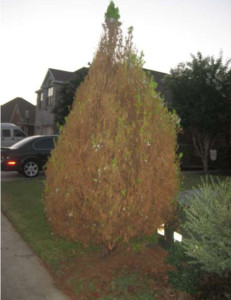In one sense bagworms are not an especially devastating pest. They have only a single generation each year (therefore are relatively slow to establish) and they don’t spread very quickly, because the female bagworms are wingless. On the other hand, they are well protected from many pesticides by their tight, water-repellent bags. They are also one of our few chewing pests that will tackle evergreen trees and shrubs.
If you’ve ever seen a deciduous tree (one that loses its leaves in the fall) defoliated by caterpillars you may have noticed that, if otherwise healthy, the tree will quickly re-leaf and recover within a few weeks. Evergreen trees, on the other hand, are very slow to re-sprout, releaf and regenerate. This leads to the question, “when is damage to an evergreen tree fatal?” Or maybe more importantly, “when is an evergreen tree no longer worth saving?”
Unless a tree is in the wild, chances are that it is being grown for appearance and aesthetic purposes. When a tree no longer looks pretty, and holds little promise of looking nice for a long time, then maybe it has lost its value and should be cut down, just as if it had died. This is likely to be the case for many bagworm-infested evergreen trees where bagworms were not controlled early or well enough to halt damage. The tree in the image above, for example, still has live foliage, but it will take a long time to regain its former green-ness or natural shape (if it survives).
According to Matt Grubisich, urban forester with Urban Renewal consulting in Arlington, TX, once an evergreen tree like red cedar or Italian cypress is more than 50% defoliated, chances are good it will not recover. “The housing development where I live recently lost a complete row of 20 eastern red cedars from a heavy bagworm infestation,” he said. Matt also noted that if a tree loses its growing point, it will not likely get a new top and will look forever stunted.
There may be no single right answer as to whether you should try to save a badly defoliated evergreen tree, but ask yourself whether you will be happy with waiting several years for a heavily defoliated tree to fill out and return to health (if it will). If you have multiple trees that form a windbreak or frame an entry point, and one is defoliated, the effect will be forever lost, and replanting may be the best choice.
If you have a partly defoliated, but live, evergreen tree, and want to try to save it, Matt recommends pruning out the defoliated sections. If it’s a young plant, he suggests supplemental watering to help it through the hot summer. If it’s an older, well established tree, supplemental water may be less necessary. Be prepared to wait several years for that tree to regain its former shape and appearance.
To avoid the problem, remember to check your trees in May for the first signs of young bagworms and treat early with a low-impact or conventional pesticide. See my earlier post about bagworms and some of the stories of woe posted by readers.
